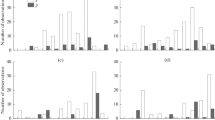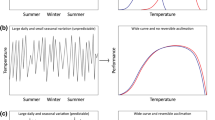Synopsis
Sixteen yearling winter flounder, tested individually for 3-day periods in electronic shuttleboxes, voluntarily occupied an 8–27°C range of temperature, with a modal final thermal preferendum of 18.5°C (mean 18.7°C, median 19°C, midpoint 17.5°C, s.d. 1.9°C, S k + 0.33). The locomotor activity pattern of the yearling fish in the laboratory was markedly nocturnal, with mean hourly nocturnal activity exceeding mean hourly diurnal activity by a factor of 3.4. Maximum activity occurred at 0300 EST, minimum activity at 1400 EST. While activity generally increased with temperature, a local activity minimum occurred at 18.7°C, coinciding with the 24-hour mean final thermal preferendum. Comparison of these laboratory data with previously published field data suggest that behavioral responses to temperature and light play significant roles in determining age- and size-specific differences in seasonal depth stratification and onshore-offshore distributions in this species.
Similar content being viewed by others
References cited
Bigelow, H.B. & W.C. Schroeder. 1953. Fishes of the Gulf of Maine. U.S. Government Fishery Bulletin No. 74. 577 pp.
Hoff, J.G. & J.R. Westman. 1966. The temperature tolerances of three species of marine fishes. J. Marine Res. 24: 131–140.
Klein-MacPhee, G. 1978. Synopsis of biological data for the winter flounder, Pseudopleuronectes americanus (Walbaum). NOAA Techn. Rept. NMFS Circular No. 414; FAO Fisheries Synopsis No. 117. 43 pp.
McCracken, F.D. 1963. Seasonal movements of the winter flounder, Pseudopleuronectes americanus (Walbaum), on the Atlantic coast. J. Fish. Res. Board Can. 34: 749–752.
Olla, L.B., R. Wicklund & S. Wilk. 1969. Behavior of winter flounder in a natural habitat. Trans. Amer. Fish. Soc. 98: 717–720.
Radle, E.W. 1971. A partial life history of the winter flounder (Pseudopleuronectes americanus) exposed to thermal addition in an estuary, Indian River Bay, Delaware. M.S. Thesis, Univ. Delaware, Lewes. 74 pp.
Reynolds, W.W. 1977. Fish orientation behavior: an electronic device for studying simultaneous responses to two variables. J. Fish. Res. Board Can. 34: 300–304.
Reynolds, W.W. & M.E. Casterlin. 1978. Ontogenetic change in preferred temperature and diel activity of the yellow bullhead, Ictalurus natalis. Comp. Biochem. Physiol. 59A: 409–411.
Reynolds, W.W. & M.E. Casterlin. 1979. Behavioral thermoregulation and the ‘final preferendum’ paradigm. Amer. Zool. 19: 211–224.
Reynolds, W.W. & M.E. Casterlin. 1980. The role of temperature in the environmental physiology of fishes. pp. 497–518. In: M.A. Ali (ed.) Environmental Physiology of Fishes, Plenum Press, New York.
Richards, F.P., W.W. Reynolds, R.W. McCauley, L.I. Crawshaw, C.C. Coutant & J.J. Gift. 1977. Temperature preference studies in environmental impact assessments: an overview with procedural recommendations. J. Fish. Res. Board Can. 34: 728–761.
Author information
Authors and Affiliations
Rights and permissions
About this article
Cite this article
Casterlin, M.E., Reynolds, W.W. Thermoregulatory behavior and diel activity of yearling winter flounder, Pseudopleuronectes americanus (Walbaum). Environ Biol Fish 7, 177–180 (1982). https://doi.org/10.1007/BF00001789
Received:
Accepted:
Issue Date:
DOI: https://doi.org/10.1007/BF00001789




